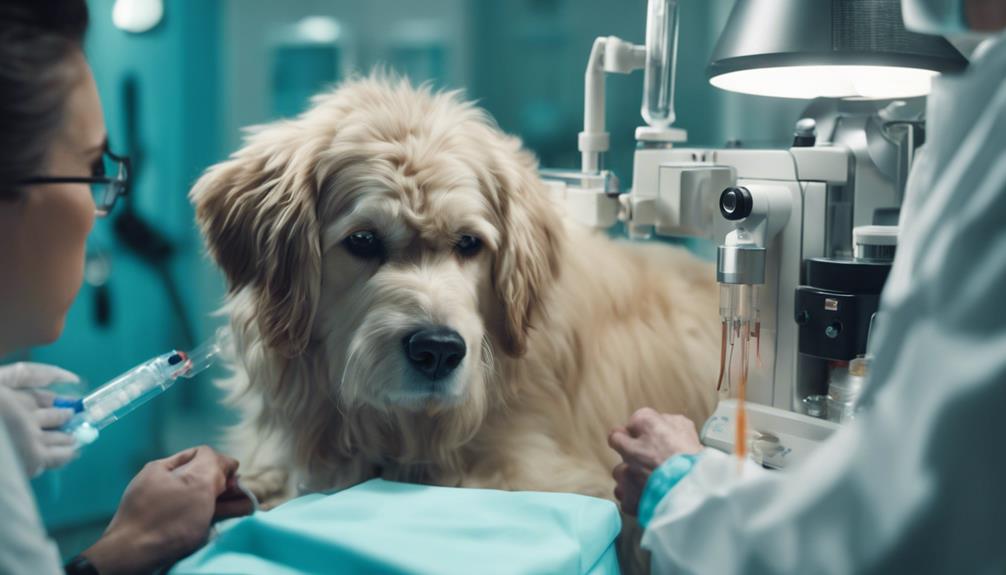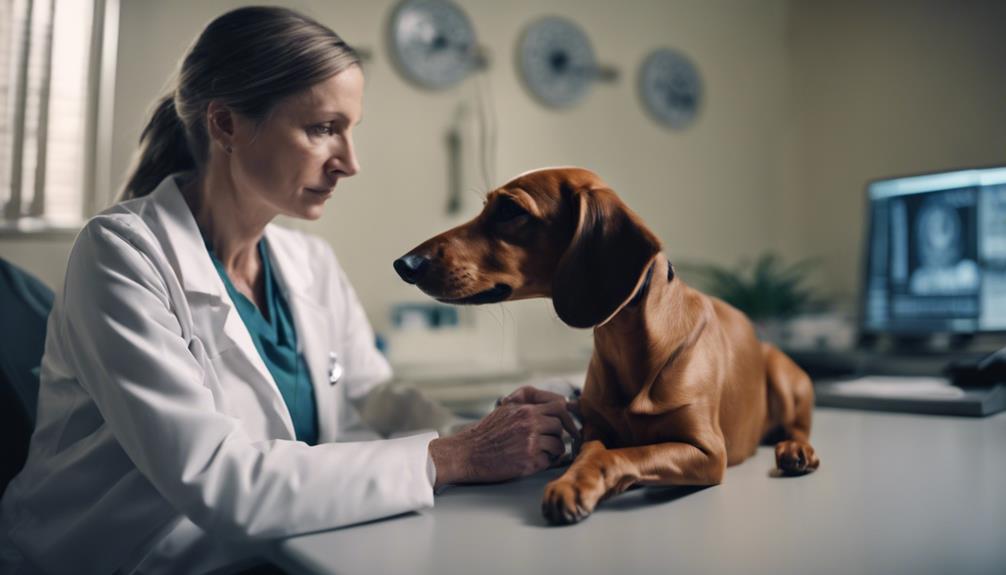In the realm of veterinary medicine, the diagnosis and treatment of Intervertebral Disc Disease (IVDD) in dogs are crucial aspects that demand attention and understanding from pet owners.
From identifying early warning signs to implementing appropriate interventions, the journey of managing a pup's spinal health can be both intricate and rewarding.
By exploring the multifaceted nature of IVDD, including diagnostic protocols and treatment options, pet owners can navigate this challenging terrain with informed decision-making and compassion towards their beloved companions.
Key Takeaways
- Veterinary tests, mainly MRI, diagnose IVDD accurately.
- Strengthen core muscles for prevention and recovery.
- Surgical and non-surgical treatments available for IVDD.
- Consult vets for personalized treatment plans and monitoring.
Understanding IVDD in Dogs
What are the key aspects of IVDD in dogs that every pet owner should understand to ensure early detection and proper management?
Intervertebral Disc Disease (IVDD) in dogs involves the degeneration or herniation of intervertebral discs, affecting spinal cord function. Commonly caused by aging or trauma, symptoms range from mild discomfort to severe paralysis.
Diagnosis requires veterinary evaluation, often utilizing MRI for accurate assessment. Certain breeds, like Dachshunds, are predisposed to IVDD. Prevention strategies focus on maintaining core strength through exercise.
Treatment options vary from surgery to conservative approaches, with surgery being more effective in severe cases. Pet owners should consult veterinarians promptly upon observing any signs of IVDD to ensure timely intervention and optimal outcomes.
Causes and Symptoms of IVDD
Intervertebral Disc Disease (IVDD) in dogs is primarily caused by the degeneration or herniation of intervertebral discs, resulting in varying symptoms from mild discomfort to severe paralysis. The degeneration of these discs, often associated with aging, can lead to their weakening and potential rupture, causing pain and neurological issues.
Trauma, such as excessive pressure on the spine, can also contribute to disc herniation. Symptoms of IVDD can range from reluctance to move, sensitivity to touch, muscle weakness, to loss of bladder or bowel control in severe cases. Recognizing these signs early is crucial for prompt diagnosis and treatment to prevent further complications.
Diagnostic Tests for IVDD

Diagnostic tests play a crucial role in confirming the presence of IVDD in dogs and guiding appropriate treatment strategies. When suspecting IVDD, veterinarians typically begin with a thorough physical examination to assess neurological function and pain response. Radiographic imaging, such as x-rays, can provide initial insights into changes in the spine.
However, the definitive diagnostic method for IVDD is an MRI scan, which offers detailed visualization of the intervertebral discs and any associated spinal cord compression. Additionally, myelograms may be used to highlight specific areas of concern within the spinal canal.
These diagnostic tests not only confirm the presence of IVDD but also help determine the extent of the condition, aiding in the development of an effective treatment plan.
Risk Factors for IVDD
One prominent factor influencing the likelihood of developing IVDD in dogs is the inherent predisposition within certain breeds. Breeds like Dachshunds, Beagles, and Bulldogs are particularly prone to this condition due to genetic factors that affect the structure of their intervertebral discs.
Additionally, factors such as age, weight, and physical activity levels can contribute to the risk of IVDD development. Dogs that are overweight or engage in high-impact activities may experience increased pressure on their spinal discs, making them more susceptible to disc degeneration and herniation.
Understanding these risk factors can help dog owners take preventive measures to minimize the chances of their pets developing IVDD.
Prevention Strategies for IVDD

Implementing consistent, targeted exercise routines can significantly contribute to reducing the risk of intervertebral disc disease (IVDD) in dogs, especially in breeds prone to this spinal condition. Exercise plays a crucial role in strengthening the muscles supporting the spine, including the core muscles, which help stabilize the vertebral column.
For dogs predisposed to IVDD, such as Dachshunds, maintaining a healthy weight through regular physical activity is essential in preventing excessive strain on the intervertebral discs. Additionally, activities that promote flexibility and agility can further improve spinal health.
Importance of Core Strength
Enhancing core strength is paramount in safeguarding against the development and progression of intervertebral disc disease (IVDD) in dogs, particularly those predisposed to spinal issues like Dachshunds. Strengthening the core muscles plays a crucial role in providing support to the spine and reducing the strain on intervertebral discs.
By improving core strength through targeted exercises and activities, dog owners can help prevent excessive pressure on the spinal column, decreasing the likelihood of disc herniation and related issues. Additionally, a strong core enhances overall stability and mobility, which can be beneficial for dogs at risk of developing IVDD or those already diagnosed with the condition.
Regular exercise routines focusing on core strength maintenance are essential for the well-being of these dogs.
Treatment Options for IVDD

When addressing intervertebral disc disease (IVDD) in dogs, a range of treatment options exists to alleviate symptoms and improve the quality of life for affected animals. These treatments aim to manage pain, reduce inflammation, and restore mobility. Here are some common treatment options:
- Pain Medications: Often prescribed to alleviate discomfort and improve the dog's quality of life.
- Anti-Inflammatory Medications: Help reduce inflammation around the affected spinal cord area.
- Physical Therapy: Exercises and rehabilitation techniques can aid in strengthening muscles and improving mobility.
- Acupuncture: Alternative therapy that may help alleviate pain and improve overall well-being.
Each dog may respond differently to treatments, so consulting with a veterinarian to determine the most suitable approach is essential for effective management of IVDD.
Surgical Approaches for IVDD
Surgical intervention is a crucial aspect in the comprehensive management of intervertebral disc disease (IVDD) in dogs. When conservative treatments fail to alleviate severe symptoms or in cases of paralysis, surgery becomes necessary.
The primary goal of surgical approaches is to relieve pressure on the spinal cord caused by herniated discs and restore mobility to the affected dog. Common surgical techniques include hemilaminectomy, dorsal laminectomy, and fenestration. These procedures aim to remove the damaged disc material, decompress the spinal cord, and stabilize the affected area.
While surgery carries risks like any invasive procedure, it is often the most effective way to address severe IVDD cases and improve the long-term quality of life for dogs suffering from this condition.
Non-Surgical Treatments for IVDD

In cases where surgical intervention is not deemed necessary for the management of intervertebral disc disease (IVDD) in dogs, non-surgical treatments offer alternative approaches to alleviate symptoms and improve the dog's quality of life.
Non-Surgical Treatment Options for IVDD:
- Pain Medications: Help in managing discomfort and improving mobility.
- Acupuncture: Can aid in pain relief and promote healing.
- Physical Therapy: Exercises tailored to strengthen muscles and improve flexibility.
- Weight Management: Maintaining a healthy weight reduces strain on the spine and promotes overall well-being.
Recovery and Patience
Rehabilitation following non-surgical treatment for intervertebral disc disease (IVDD) in dogs requires a steadfast commitment to the principles of recovery and patience. While non-surgical approaches like pain management, physical therapy, and restricted activity can be effective, the road to recovery may be longer than expected.
It is essential for pet owners to understand that healing from IVDD is a gradual process that demands patience and consistency. Progress may be slow, and setbacks can occur, but with dedication to the prescribed treatment plan and regular communication with the veterinarian, improvements can be achieved.
Monitoring the dog's mobility, pain levels, and overall well-being is crucial during this recovery phase to ensure the best possible outcome.
Euthanasia Consideration

When faced with severe cases of intervertebral disc disease (IVDD) in dogs, pet owners may find themselves contemplating difficult decisions regarding end-of-life care. It is essential to approach this sensitive topic with compassion and understanding. Here are some considerations for pet owners:
- Quality of Life Assessment: Evaluate your dog's current quality of life to determine if they are experiencing more pain than pleasure.
- Consultation with Veterinarian: Discuss the prognosis and treatment options with your veterinarian to make an informed decision.
- Emotional Support: Seek support from friends, family, or support groups to help you cope with this challenging decision.
- Consideration of Palliative Care: Explore palliative care options to ensure your dog's comfort and well-being in their final days.
Surgical Vs. Non-Surgical Decisions
When faced with intervertebral disc disease (IVDD) in dogs, making the decision between surgical and non-surgical treatments requires careful consideration of potential outcomes and risks.
Surgical intervention, while historically primary, is a costly yet effective option for severe cases of IVDD. It aims to relieve spinal cord pressure and restore mobility.
On the other hand, non-surgical alternatives such as pain medications, acupuncture, and physical therapy carry lower risks compared to surgery. These conservative treatments can lead to successful recovery, particularly when used in combination. Acupuncture and targeted exercises play a vital role in improving mobility post-diagnosis.
Consulting with veterinarians is essential to evaluate the best course of action based on the individual dog's condition and needs.
Consulting Veterinarians for IVDD

In navigating the complexities of treating intervertebral disc disease (IVDD) in dogs, engaging with veterinary professionals is crucial for informed decision-making regarding the best course of action for the individual dog's condition and well-being.
When consulting veterinarians for IVDD, consider the following:
- Comprehensive Evaluation: Vets can conduct thorough assessments to determine the severity and extent of the spinal issue.
- Treatment Recommendations: Professionals can recommend suitable treatment options, whether surgical or non-surgical, based on the dog's specific needs.
- Monitoring Progress: Vets play a vital role in monitoring the dog's progress post-treatment and adjusting plans accordingly.
- Expert Guidance: Veterinarians offer tailored advice, considering factors like the dog's age, breed, and overall health status, to ensure the most appropriate care.
Monitoring and Follow-Up
Effective monitoring and follow-up are essential components in the comprehensive care plan for dogs diagnosed with intervertebral disc disease (IVDD). After initial treatment, regular check-ups are necessary to assess the dog's progress, make any necessary adjustments to the treatment plan, and monitor for any potential complications.
These follow-up appointments allow veterinarians to track improvements, evaluate the effectiveness of the chosen treatment approach, and address any new symptoms or concerns that may arise. Monitoring may involve physical examinations, neurological assessments, imaging tests, and pain evaluations to ensure the dog's well-being and quality of life.
Conclusion
In conclusion, Intervertebral Disc Disease (IVDD) in dogs is a complex condition that requires careful consideration and management.
By understanding the causes, symptoms, and diagnostic tests for IVDD, pet owners can take proactive measures to prevent and address spinal problems in their canine companions.
Consulting with veterinary professionals and exploring treatment options, such as surgical or non-surgical interventions, play a crucial role in ensuring the well-being of dogs affected by IVDD.
Monitoring and follow-up are essential in managing this condition effectively.




